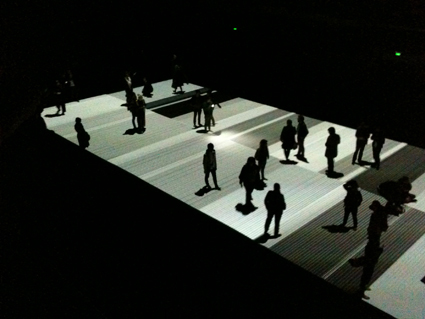 |
Ryoji Ikeda, Test Patter, Carriageworks |
Heading the didactic panel for test pattern is a quote from Ikeda:
“To me, beauty is crystal: rationality, precision, simplicity, elegance, delicacy. The sublime is infinity, infinitesimal, immensity, indescribable, ineffable.”
But first, datamatics [ver 2.0], which, it turns out, is all of the above. A near-monochrome diamond-cut of ones and zeros flying faster than the eye can grasp; an hour of heartbeat-paced, Morse-toned pips and subliminal surges.
What I’ll call Act I is pure 2D surface: black screen, white bars, barcodes, churning letters and numbers, an infinite, ever-changing scroll of data that approaches the vertiginous – seasickness is somewhere just beyond the peripheral vision. Infinitesimally high-pitched pips and chest-numbing hums accompany a flickering rainfall of unintelligible information. But it’s not long before the unprocessable begins to be processed – not only do letters and numbers become readable despite their impossible frame rate; it seems abstraction can only exist for so long before representation rears its head. Vertical lines gain ‘heads’ and become pins; tilted on an angle they become a fully-strung loom, then a dance; horizontal galloping frames are passing trains… But most of all, black becomes black-ness – a space – and everything white moves forward out of the surface, floating.
And it’s space that dominates in a slowly-turning ‘Act II’. Not only a mapped-out universe whose anonymous stars are sequentially named and positioned; it’s a spatial landscape too of submarine pings into the echoing deep. What emerges from it is a profound representation of the impact of mathematics on the world, the endless grid of ‘knowledge’ that positions everything from clustering stars to swarming starlings; weaving ubiquitous right-angled webs and grids across everything that moves. The 3D scanner replaces the barcode, its octave span of lock-in tones works into a slow, lulling rhythm.
From rotating starbeds to a white space-scape in which an architecture is drawn, layer upon layer – linking white dots that flock like blossom then clouds of birds then fine hexagonal molecules in complex formations. Cumulatively, inexorably, Ikeda expresses a beauty of mathematisation – and maps out an almost tangible spatial realm between the data and its representation.
datamatics [ver 2.0] escapes its scenic structure towards the end, compounding and decaying: masses of moving white dots compete with a glitch across their geographical field; 2D and 3D, black, white, grey, binary and organic forms share the screen in blinding succession. Axes and rhythms continue to bind together a now-overwhelming mass of coordinates, an obsession with the cross-hair, with the heartbeat, with the infinite and the minute. Ultimately, thumbnails from previous screens appear embedded in the endlessly scrolling raw data, like glimpses of the creator from a world (or an edit-suite) afar. Flashes of sepia seem to fly by, even single frames of colour amid what now sounds like a toned-out, machinic drum and bass track. Colour? Data might technically be dead-matter but the screens seem alive: it’s clinical and pulsing, and I’m starting to doubt what I’m seeing. Colour?
And then it ends. And then I’m next door, taking off my shoes and stepping onto an enormous, strobing field of light: Ikeda’s test pattern. Like a distillation (or expansion) of datamatics [ver 2.0] into literal space, test pattern is conveyer-belting barcodes flying across the floor at hundreds of frames a second – plus humans standing around in the middle of it. Their clothes are coloured, they have curves, hair, bags, all illuminated by the streaming light under their feet. This is not a work of abstraction, it’s literally alive. The sound is less ’scape and more securely ‘music’: nevertheless it drills sensual holes into the skull.
From above – and this is the great beauty of test pattern, its gallery view down onto the floor – the people below are like the clots of live matter in datamatics [ver 2.0]. There may be a dark side – at times they seem oblivious of the conveyer-belt that might be transporting them, observable only from the outside…But most of all it seems like a bizarre picnic: clusters of visitors sitting around, chatting even, in the blinding, strobing light, apparently undisturbed by their absorption into the data matrix.
In datamatics [ver 2.0] the natural world evolves from abstraction, it’s mobile and is pinned down by line and coordinate. Participating in test pattern, the natural and the unpredictable – the human element – is relatively still against the streaming data, relentless metaphor for an infinitely mathematised world. Seen together, both works are utterly immersive – the former through eyes and ears, and the latter through our actual presence in the work; surrounded by a black-and-white that’s both meaningless and potent, and where the real information is in our own human form.
Ryoji Ikeda, datamatics [ver 2.0], Carriageworks , 7 June; test pattern, 8 June 1 July; presented by Carriageworks, ISEA2013 in collaboration with Vivid Sydney; http://www.isea2013.org/
This article first appeared on RT's ISEA2013-in RealTime blog
© Urszula Dawkins; for permission to reproduce apply to [email protected]








 back
back